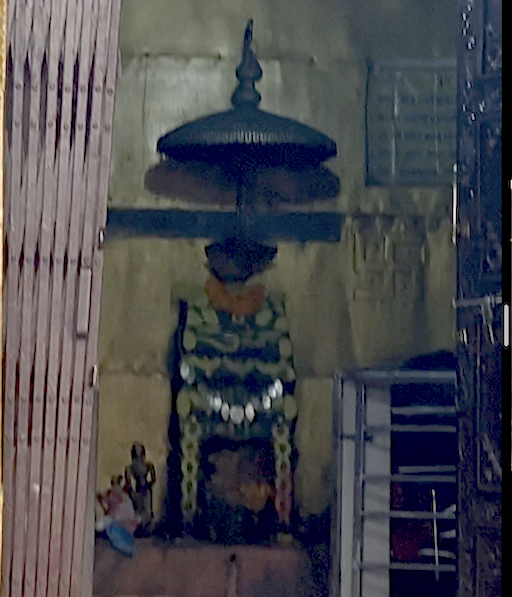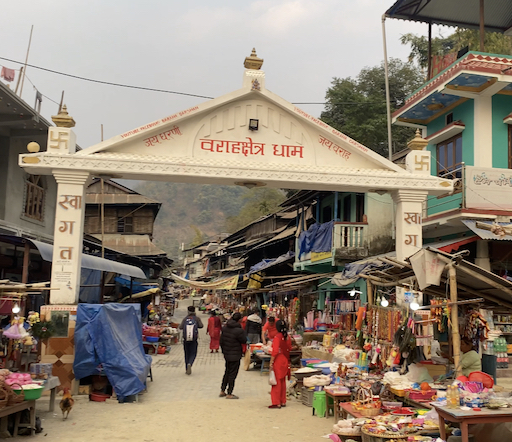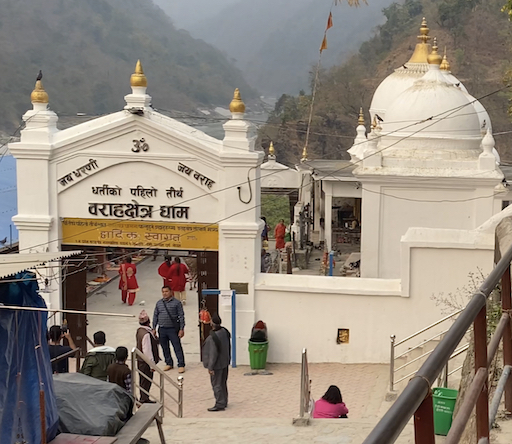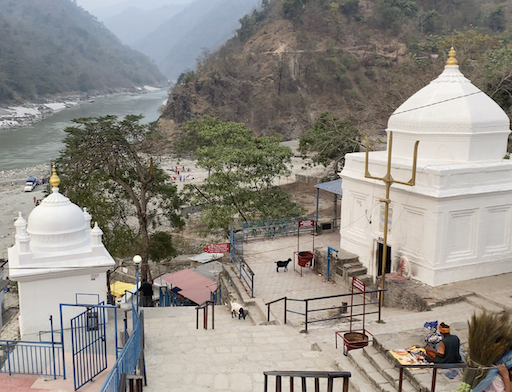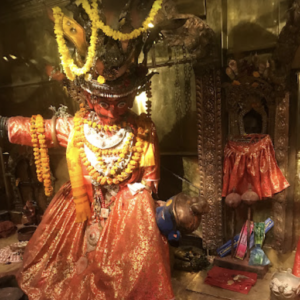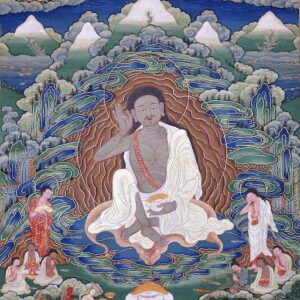This is a consecrated temple of Baraha Deity. There is a place to sit and meditate. You can go into meditative states here effortlessly.
How to Get there
The temple is located on the way to Barahakshetra, 22 kms North West of Dharan. The best way is to take your own vehicle or take an auto.
Map: https://goo.gl/maps/xrHytH6475LSGxUo6
About Barahakshetra
Barahachhetra (also Barahakshetra or Varahakshrata; Nepali: वराहक्षेत्र) is a Hindu and Kirat piligram site[1] which remains between the confluence of Koka and Koshi rivers in Barahakshetra, Sunsari of Koshi Province, Nepal. This place is one of Nepal’s oldest shrines mentioned in Puranas including Brahma Purana, Varaha Purana and Skanda Purana and even mentioned and glorified in the Mahabharata epic. In Barahachhetra, the Varah, an incarnation of Vishnu is worshiped. Barahachhetra is one of the Char Dham in Nepal.[2][3]
This place is located at about 5 km North West from Dharan in Sunsari district. The present appearance of the original temple of Barahachhetra was made in 1991 BS. The temple was rebuilt by Juddha Shamsher for the last time in 1991 BS after the temple was demolished by the earthquake of 1990 BS. There are 9 temples including that of Laxmi, Panchayan, Guruvarah, Suryavarah, Kokawarah and Nageshwar and many hospices in Barahachhetra. Statues of more than 1500 years old have been found in this place.
Pilgrims come all seasons but special fete is organised in occasions of kartik purnima and makar sakranti. People from India prefer to come Barahachhetra in kartik purnima and people from hilly Nepal generally come at makar sakranti. Except this, huge number of pilgrims arrive at rishi panchami, byas panchami, fagu purnima and other ekadashis or other fasts and festive days. Each day seems like a fete due to regular flow of people.
Lord Vishnu, by taking the incarnation of Varaha or Baraha protected the earth from being submerged into Patala (underworld) with his long tusk. Then the Lord sat with his wife Laxmi at the bank of Koshi River in the lap of Himalayas and hills. So, the place bore its name after that event. There is a big and beautiful image of the Baraha incarnation of Lord Vishnu.
Source
https://en.wikipedia.org/wiki/Barahakshetra
This is a consecrated temple of Baraha Deity. There is a place to sit and meditate. You can go into meditative states here effortlessly.
How to Get there
The temple is located on the way to Barahakshetra, 22 kms North West of Dharan. The best way is to take your own vehicle or take an auto.
Map: https://goo.gl/maps/xrHytH6475LSGxUo6
About Barahakshetra
Barahachhetra (also Barahakshetra or Varahakshrata; Nepali: वराहक्षेत्र) is a Hindu and Kirat piligram site[1] which remains between the confluence of Koka and Koshi rivers in Barahakshetra, Sunsari of Koshi Province, Nepal. This place is one of Nepal’s oldest shrines mentioned in Puranas including Brahma Purana, Varaha Purana and Skanda Purana and even mentioned and glorified in the Mahabharata epic. In Barahachhetra, the Varah, an incarnation of Vishnu is worshiped. Barahachhetra is one of the Char Dham in Nepal.[2][3]
This place is located at about 5 km North West from Dharan in Sunsari district. The present appearance of the original temple of Barahachhetra was made in 1991 BS. The temple was rebuilt by Juddha Shamsher for the last time in 1991 BS after the temple was demolished by the earthquake of 1990 BS. There are 9 temples including that of Laxmi, Panchayan, Guruvarah, Suryavarah, Kokawarah and Nageshwar and many hospices in Barahachhetra. Statues of more than 1500 years old have been found in this place.
Pilgrims come all seasons but special fete is organised in occasions of kartik purnima and makar sakranti. People from India prefer to come Barahachhetra in kartik purnima and people from hilly Nepal generally come at makar sakranti. Except this, huge number of pilgrims arrive at rishi panchami, byas panchami, fagu purnima and other ekadashis or other fasts and festive days. Each day seems like a fete due to regular flow of people.
Lord Vishnu, by taking the incarnation of Varaha or Baraha protected the earth from being submerged into Patala (underworld) with his long tusk. Then the Lord sat with his wife Laxmi at the bank of Koshi River in the lap of Himalayas and hills. So, the place bore its name after that event. There is a big and beautiful image of the Baraha incarnation of Lord Vishnu.
Source
https://en.wikipedia.org/wiki/Barahakshetra
